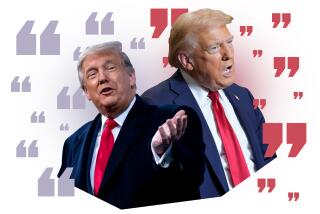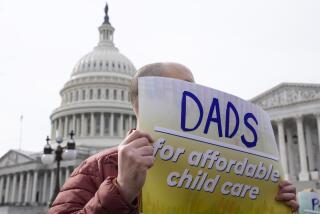Clinton Uses State of Union to Show Activist President
WASHINGTON â For nine decades, beginning with Woodrow Wilson, presidents have spent one evening early in the year presenting their annual legislative agenda by delivering a formal State of the Union address to Congress.
But in 1998, stung by criticism that he had already become a lame duck in the first year of his second term, Bill Clinton decided to stretch the traditional State of the Union address into a monthâs worth of major announcements.
On Sunday it was Social Security reform. Then came balancing the budget (Monday), expanding Medicare (Tuesday) and boosting child care (Wednesday). Friday was education day.
âWe had a very clear strategy,â said Rahm Emanuel, one of Clintonâs chief policy advisors. âThe State of the Union is no longer an evening, but a month.â
Instead of making one big news splash the day after the State of the Union, which Clinton will deliver Jan. 27, the White House pronouncements have generated a series of television news reports and front-page headlines.
âWeâre busy, weâre not golfing,â quipped one White House insider, reflecting recent criticism that Clinton had become a caretaker president more concerned with improving his golf game than with crafting public policy.
The overriding objective, according to administration officials, is to showcase an activist president at work, finding innovative ways to address Americaâs social problems within the context of a balanced federal budget.
Republicans attribute it to a less lofty motive, arguing that Clinton is merely trying to avoid being tagged again as a big-spending Democrat.
The Clinton White House is not the first to tip his policy hand in advance of the State of the Union address. In fact, there is a long tradition of selective âleaksâ to news organizations of some elements of the chief executiveâs legislative priorities.
But such stories generally have appeared in the final few days before the annual address to both houses of Congress. The Clinton campaign of high-profile announcements and orchestrated leaks starting a month before the big night represents a genuine innovation in presidential promotion.
*
Last year, Clintonâs shop previewed some presidential initiatives before the State of the Union. But with the inauguration and a round of new Cabinet appointments grabbing the headlines, the drum roll did not get nearly as much attention as it has this year.
This time around, Clintonâs top aides purposefully devised a game plan designed to define the yearâs legislative agenda by rolling out most major elements of his agenda long before Congress even returns to town from its recess.
âWe wanted to come out of the holidays and make a real impression that we were on the move and that the Republicans were responding to our agenda,â Emanuel acknowledged.
During three or four sessions in early December, the presidentâs top domestic policy advisors decided which issues to introduce before the actual address, and by what means. Some were deliberately leaked to two newspapers that the White House was confident would place them on their front pages and that circulate widely within the Washington media establishment: the New York Times and the Washington Post, officials said.
One strategic decision was made in a conference call involving a number of administration officials scattered across the country in various vacation locales, Emanuel said. They decided to make a definitive pledge to reform Social Security within the next two years and to leak the news to the Post for use in last Sundayâs editions.
Their goal was to make it the leading topic on the weekend talk shows, and it worked.
âThereâs a news and policy agenda vacuum in January,â said another senior White House official who requested anonymity. âIf youâre not careful, someone else is going to grab it. Both sides want to grab it. Itâs through this very conscious work that weâve driven the agenda.â
Some Republicans conceded that Clinton has stolen the show so far but warned that his moment in the spotlight wonât last forever.
âHe has the bully pulpit; heâs using it well this week,â said Ari Fleisher, spokesman for the House Ways and Means Committee, which has jurisdiction over many of Clintonâs new legislative proposals. âHeâs showing himself to be energetic and full of small ideas. Youâll have to judge in the future whether he can deliver.â
In the long run, Republicans stressed, the GOP will regain the initiative because it controls Congress and 32 of the nationâs governorships.
âI donât worry about it,â said Rep. Bill Paxon (R-N.Y.). âMost of the real ideas at play in the country . . . are Republican ideas.â
Analysts suggested that the White House strategy will succeed in muting, at least for a time, recent characterizations of Clinton as a president who came to office full of big ideas only to become a chief executive without an agenda.
âHe was rocked by the year-end assessments that he was more interested in golf than public policy, so heâs come out in the new year looking like an activist,â said Stephen Hess, an analyst at the Brookings Institution, a Washington think tank. âItâs very clever for public relations and political reasons: Itâs a slow time, and they are getting lead stories day after day on things that would literally be buried in a story about the State of the Union the next day.â
A positive consequence, Hess added, is that the separate announcements are generating more debate about specific initiatives, such as Clintonâs proposals to make Medicare available to early retirees and to provide tax breaks and subsidies to help pay for child care.
*
But Hess agreed with Republican critics who contend that none of Clintonâs proposals is truly groundbreaking. âMaybe they think if they do enough little things it can add up to one big thing.â
Although no president appears to have used the tactic as extensively as Clinton, some of his predecessors also tried to play the game.
During Ronald Reaganâs first month in the White House, he scooped his address to Congress by unveiling a proposed 10% tax cut in a nationally televised address. The goal was to focus the American public on that particular initiative before Reagan even took the podium in the House chamber, according to Marlin Fitzwater, press secretary for Presidents Reagan and Bush.
Whether to hold your cards or tip your hand before a formal announcement is an important decision for any president, Fitzwater said, because it is âthe biggest kind of manipulation you have available to you.â
Despite Reaganâs preview of his tax-cut plan, during the 12 years of the Reagan-Bush era the White House generally placed a premium on saving all the elements of the agenda for the big night. That enabled the president to emphasize one principal theme, such as reducing the deficit or reining in government spending.
*
âThe overall philosophy or direction was the primary objective,â Fitzwater said. âThe emphasis was on one big splash that gave the country one picture of where you were trying to go.â
In 1992, for example, the nation was mired in a recession, and Bush decided to use his State of the Union to outline an overall economic recovery plan in one fell swoop. âHe was facing reelection and wanted to present an economic program that gave the country assurances that he was turning around the economy,â Fitzwater said.
Clintonâs game plan is obviously different.
âThe Clinton strategy is clearly to lead people away from an impression that this is a big-spending return to old-time Democratic politics,â Fitzwater surmised.
âHe wants to focus on the individual initiatives as being reasonable and not too costly in terms of the budget surplus. Therefore, spreading them out in dribs and drabs seems to me to make good sense. They want people to focus on helping children, helping the elderly or helping the sick, and avoid the overall impression that the minute he gets some money he wants to spend it,â Fitzwater said.
* LESSON FROM THE TOP
President Clinton tells Latinos that quitting school amounts to âRussian roulette.â A8
More to Read
Get the L.A. Times Politics newsletter
Deeply reported insights into legislation, politics and policy from Sacramento, Washington and beyond. In your inbox three times per week.
You may occasionally receive promotional content from the Los Angeles Times.










